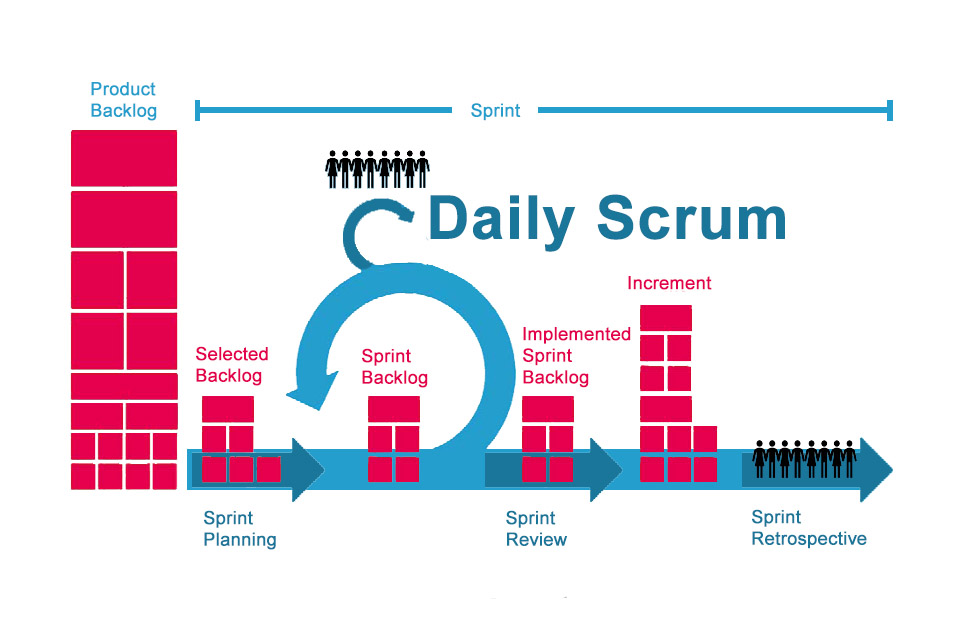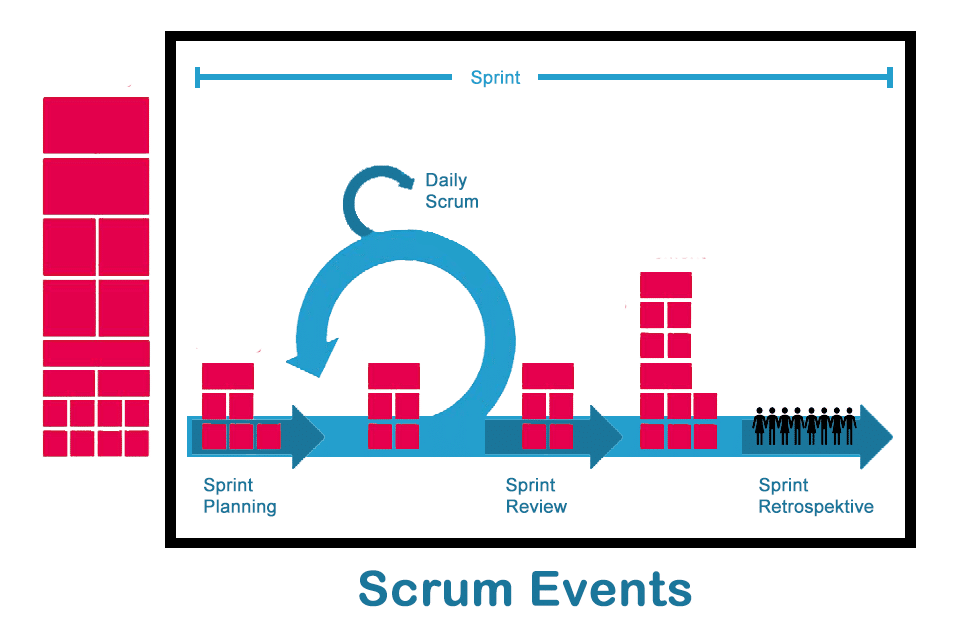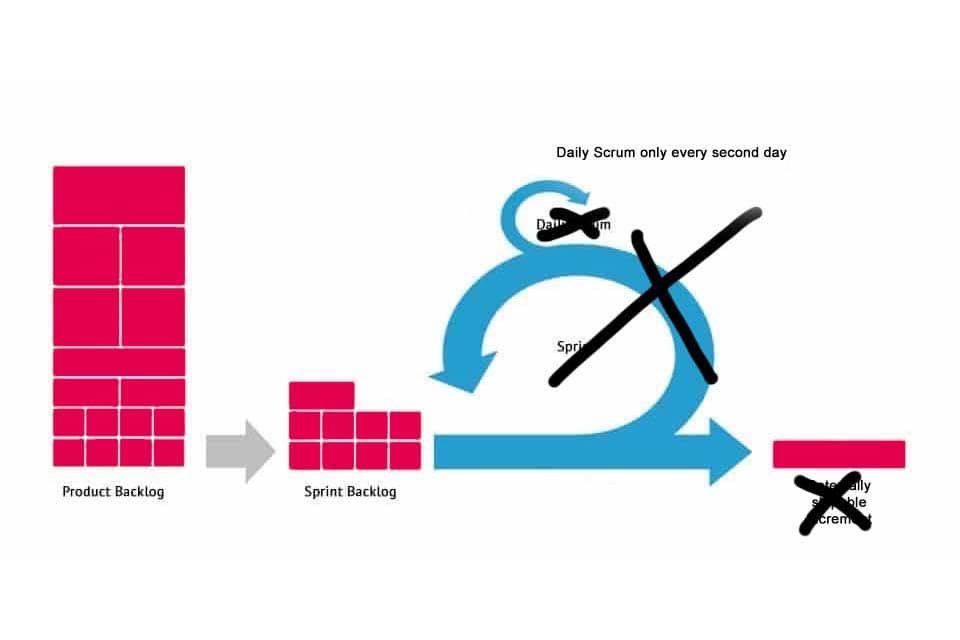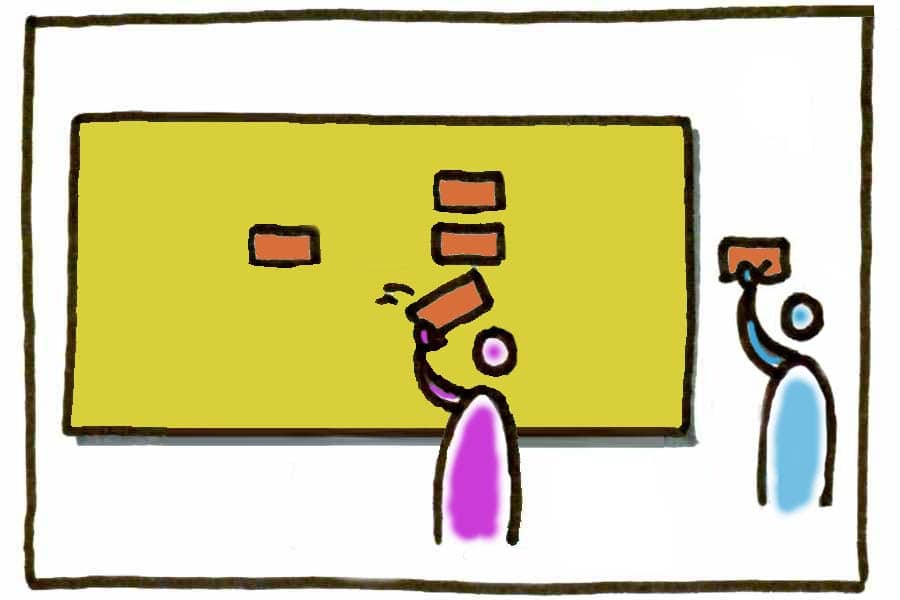What is a Daily Scrum?
Smartpedia: The Daily Scrum is a daily event for synchronisation, with the purpose of checking the progress towards the sprint goal and adjusting the planned work if necessary.
Daily Scrum Definition
The Daily Scrum is a daily event where the developers meet to exchange information about the progress towards the agreed sprint goal, the upcoming activities and possible problems or obstacles. It is a central component or event in Scrum. Since the participants usually stand in a circle for dialogue, it is also called a standup meeting or daily stand-up.
Participation in the meeting is obligatory for developers, in addition the Scrum Master should and the Product Owner could participate. Representatives from other areas such as marketing, sales or documentation can also participate in the meeting. Ideally, guests should not have the right to speak. The time, duration and location of the Daily Scrum are fixed and do not have to be arranged from meeting to meeting.
The three questions in the Daily Scrum
The Scrum Guide 2020 explains that “developers can choose any structure and technique for the event as long as their exchanges focus on progress towards the sprint goal and an actionable plan is created for the next working day”. This creates “focus and improves self-management”.
Daily Scrum is about sharing with each other, it is an understanding among equals. The information shared is not directed at line managers, not at the Scrum Master, the Product Owner or other listeners. It is about synchronisation and not about accountability.
In daily practice, three questions have proven useful in the daily stand-up, which every developer should answer:
- What have I done since yesterday to help the Scrum team achieve the sprint goal? Or: What have I achieved since yesterday?
- What do I do until tomorrow to help the Scrum Team reach the sprint goal? Or: What do I want to achieve today?
- What is preventing me or the Scrum Team from achieving the sprint goal? Or: What is standing in my way?
When answering the questions, it is important to have an individual orientation towards the sprint goal, which was set by the team and is to be achieved together. “With regard to the sprint goal, since yesterday I have …” – would be a useful sentence structure that focuses the answer on the achievement of the goal. Command-and-control gives way to self-management and team responsibility.
Two aspects are essential in the exchange with each other:
- Responsibility is not abdicated in Daily Scrum
- and there is no judgement of others.
If necessary, adjustments are agreed upon together to ensure that the sprint goal is reached. For this reason, the daily is also understood as a collaborative planning session.
Timeboxing at the Daily Scrum
Communication is very important in Scrum. Communication takes a lot of time and means effort; the concept of the timebox helps here. The Scrum Guide recommends limiting the Daily Scrum to 15 minutes. Of course, teams can also agree on 20, 25 or 30 minutes, but an extension multiplies with the number of participants. If a team decides on 25 instead of 15 minutes, this means 400 minutes of additional work per week for 8 participants, just for the coordination among each other. One or the other User Story can probably be realised in almost seven hours.
In order to keep to the agreed timebox, it is necessary to communicate meaningfully with each other. For example, it makes little sense to discuss a problem in front of the whole group if two team members can simply solve it in private. On the other hand, it also makes little sense to postpone an important discussion that affects the whole team just to keep to the timebox.
Impediments in Daily Scrum
What prevents me or the development team from achieving the sprint goal? The answer to the third question in the Daily Scrum is an impediment. An impediment is a disorder. It impedes team members in the performance of their tasks, delays individual or joint development, and consequently endangers the sprint goal.
When dealing with impediments, the Scrum Master is required either to encourage the team to remove the obstacle itself, if necessary, or to take care of the removal of the cause. Ideally, the Scrum Master should report on the progress of the impediment removal at the next Daily Scrum.
Consistent orientation towards the sprint goal
The Daily Scrum is about the planning of the day by the development team. It’s about completed and open tasks, it’s about obstacles and it’s about collaboration in the sprint. Ideally, the product owner is present and able to provide information. The Scrum Master ensures an effective process and takes care of the removal of impediments. By exchanging information, the team synchronises itself and redundancies are avoided.
It is important that the Daily Scrum does not degenerate into a compulsory event within the framework of Scrum because there is no serious exchange between the participants. If individual employees think that they could do more meaningful things during the meeting and, for example, implement individual user stories, the Daily Scrum is anything but ideal. This is where the Scrum Master is required and where orientation towards common sprint goals helps. Agile software development doesn’t mean that every single developer does his job, it means that the whole team is responsible. Every developer should be aware of this responsibility and understand the Daily Scrum as the basis for a successful cooperation. Consistent orientation towards the sprint goal helps here.
The visualisation of the work in the Daily Scrum
A central element when working with Scrum is the visualisation of the tasks in the form of a taskboard. The different tasks to implement a user story move from To Do to Work in Progress and To Verify to Done. If there are impediments to a single task, this can easily be visualised with dots.
Through the shared presentation of tasks and progress in the Daily Scrum, each team member knows what needs to be done to achieve the agreed sprint goal. Transparency and awareness of the status quo are increased.
In addition to the permanent visualisation of the tasks in the developer’s office, the manual shifting of tasks promotes the motivation of the employees to achieve the set goals. When electronic taskboards are used, the effect is less pronounced. Updating the burn-down chart does not have this effect either.
Tips for the Daily Scrum
Not all participants are always present on time at the beginning of the stand-up meeting. Opinions differ on how to act in such situations. In some organisations there is the instrument of punishment. Even the smallest amounts of money or the investment of time – e.g. for baking a cake at three delays – quickly lead to a change in behaviour.
In principle, however, it is more important to understand the background to delays. A developer who is held up by a manager may not be able to “free himself” and leave. The Scrum Master should therefore try to find out the reasons for the late arrival and then work on it together with the team or the affected team members. In most cases, this leads to lasting improvements and does not just fight the symptoms like a punishment.
Even if it is against the mutual agreement to repeat discussed content for people who arrive too late, teams must still find a solution how to communicate any information “afterwards”. Usually it is sufficient if one team member – not the Scrum Master or the Product Owner – takes over this task after the Daily Scrum.
The Daily Scrum takes place every day, as the name implies. Depending on the industry and experience, there may be considerations to change this frequency and give the team more effective working time, e.g. by holding the stand-up meeting only every 2nd day. For a 9-member team, this would be a saving of 4.5 hours in a 2-day week without the daily and 6.5 hours the following week. However, this also reduces the contact points of the team from 100% to 60% or 40%.
And what happens if information that has not been communicated leads a developer to develop an entire working day unnoticed in the wrong direction, just because there has been no coordination with his colleagues? There is information that must not be communicated with a 24-hour delay. Adjusting the frequency can therefore be risky.
According to the Scrum Guide, the Daily Scrum is not the only way for developers to adapt their plan to reality. Developers can exchange information about adjustments several times a day and discuss remaining activities. From your point of view, does it make sense to inform the Product Owner or the Scrum Master about each adaptation or is it sufficient to exchange information in the Daily Scrum the following day?
Notes:
If you like the article or would like to discuss it, please feel free to share it in your network. And if you have any comments, please do not hesitate to send us a message.
In general, speaking one after the other in a circle or nominating the next speaker, using a speech token or working through the task board from right to left are all considered good techniques to promote communication during daily exchanges.
Here you can find a Daily Scrum Checklist as a free download.
And here you will find additional information from our Smartpedia section:




